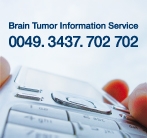Anti-epileptic Therapy
Epileptic seizures in brain tumour patients
In 60% of the patients with a primary brain tumour epileptic seizures constitute the initial symptom of the disease. In further 10 to 20% of the brain tumour patients epileptic seizures occur during the following progression of the disease. Specific types of brain tumours are accompanied by epileptic seizures more often than others. So there are at least 75% of patients suffering from gangliogliomas or oligodendrogliomas affected by epileptic seizures, 60 to 70% of the patients with astrozytomas, 15 to 20% of the patients with cerebral metastases and 15% of the patients with primary CNS-lymphomas. Particular tumour localisations come along with a higher risk of seizures as well. [extract from Brainstorm]
Epileptic seizures as symptoms of a cerebral tumour disease are generally focal seizures as they emanate from a localized nidus (lat. “focus”), the brain tissue around the tumour. They can occur as simple-focal seizures or as at the beginning focal, secondary generalized grand mal seizure with loss of consciousness.
A seizure itself most times does not last longer than 30 to 90 seconds. But as there can often exist a dysfunction of the brain subsequent to a seizure, which induces e.g. a phase of reorientation or a “deep sleep” after a grand mal, observers frequently perceive the duration of the seizure as longer.
Treatment of epileptic seizures
Through the administration of antiepileptics the recurrence risk of further seizures is being decreased. Nevertheless it is often a long way to go until the person affected has found the suitable drug in the optimal dose. This process should happen in association with an experienced neurologist or epileptologist. Especially while looking for a second opinion or in case of any problems concerning the medication of the antiepileptics patients can call on one of the certified epilepsy centres in Germany.
Weitere Informationen für Hirntumorpatienten und Angehörige
back to supportive therapy






